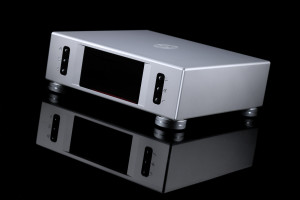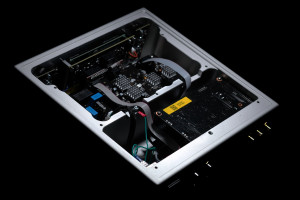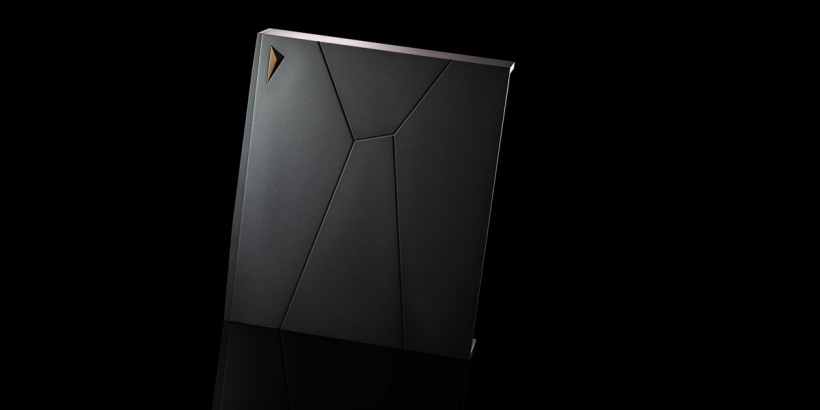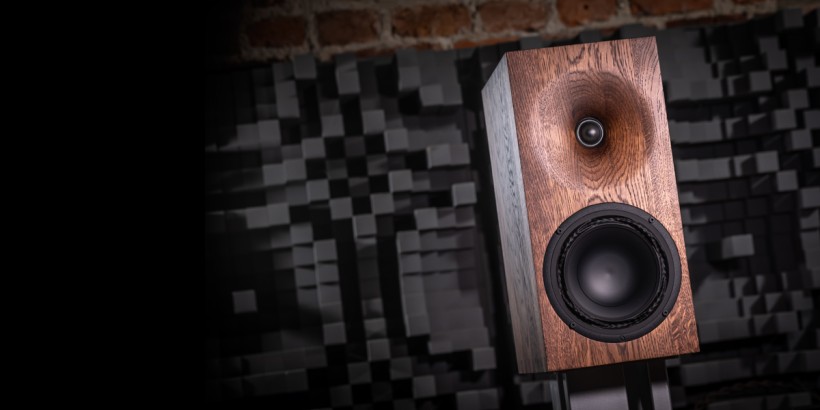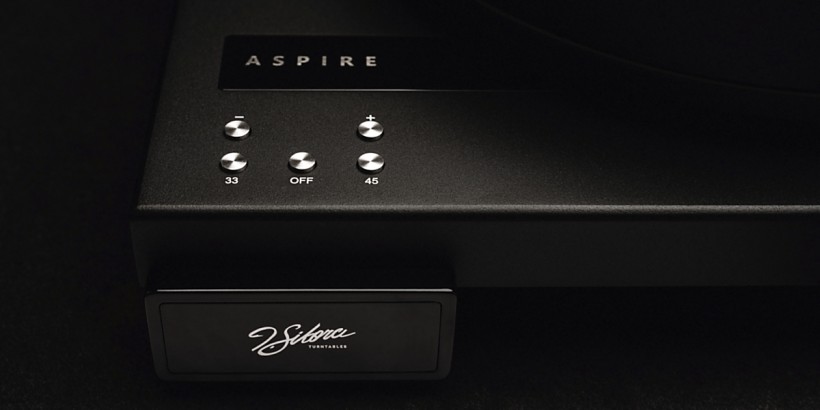AGD Productions Vivace mono amps purposely remained at my place after their recent launch at this site. Their maker already had a companion tailored for them. The arrival of AGD Productions Andante pre/DAC/phono/streamer combo naturally introduced the perfect opportunity to investigate how Alberto Guerra’s products would fare as a team. Enjoy!
Introduction
AGD Productions Vivace was awarded with our ‘Victor’ for a number of reasons. It emerged as the best class D specimen I’d heard to date, and a performer way up there with the Bakoon AMP-13R, which on sonic completeness I consider as second to none regardless of price or topology. Alberto Guerra’s petite monos had the upper hand on power output though, which resulted in perfect compliance with my Boenicke Audio W11 SE+ floorstanders. But most importantly, the man’s patented modular GaNTube™ output stage incorporated in his Vivace was unique, and not comparable to anything else on the market. Having this and Srajan’s own Andante preview in mind, I was deeply interested to see what Alberto did outside of the amplification realm, and today’s the day.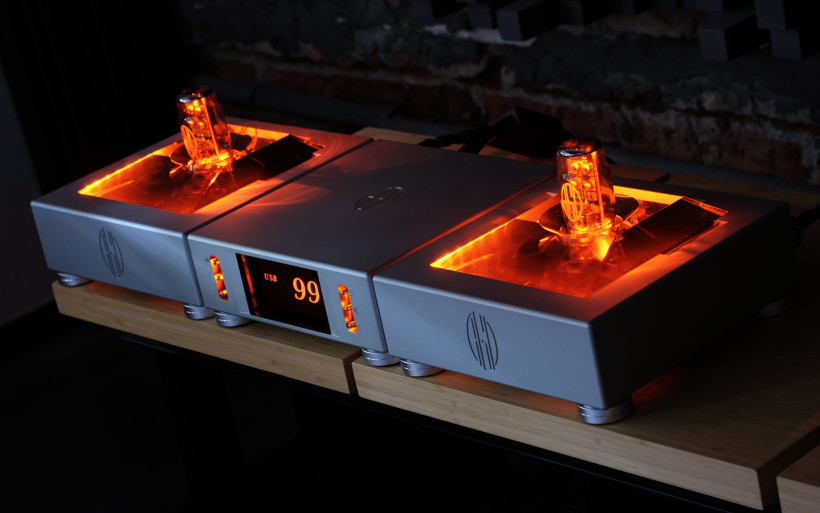 Although this might sound like a tired mantra, products outside of manufacturers’ core business always raise many similar question marks and suspicions. After all, what kind of an amp can a well-established speaker company deliver? How good a DAC can get if made by engineers into power treatment? And what about a turntable designed by an operation known for compact affordable headphone devices? This list goes on and on, but the gist is that many of us enthusiasts stick to product groups that made given audio houses famous. Although there’s nothing fundamentally wrong with this approach, it gets us a wee bit biased at times. Although oftentimes predictable to quite an extent, audio also is full of surprises. If I weren’t into it for a living, most likely I would’ve missed several great components, and I can tell you as early as now that AGD Productions Andante fits the profile. There’s far more to it than meets the eye.
Although this might sound like a tired mantra, products outside of manufacturers’ core business always raise many similar question marks and suspicions. After all, what kind of an amp can a well-established speaker company deliver? How good a DAC can get if made by engineers into power treatment? And what about a turntable designed by an operation known for compact affordable headphone devices? This list goes on and on, but the gist is that many of us enthusiasts stick to product groups that made given audio houses famous. Although there’s nothing fundamentally wrong with this approach, it gets us a wee bit biased at times. Although oftentimes predictable to quite an extent, audio also is full of surprises. If I weren’t into it for a living, most likely I would’ve missed several great components, and I can tell you as early as now that AGD Productions Andante fits the profile. There’s far more to it than meets the eye. During the first AGD Productions assignment Alberto Guerra introduced himself as a skilled audio engineer as much into unusual tech, as he was into compact sizing, upgradeability and practicality. Although on the surface this report’s Andante invoked the alike impression, the key question to ask was whether it could keep up with Vivace monos on sonic quality. Since these amps didn’t win our award for nothing, the bar for any upcoming AGD product was accordingly raised.
During the first AGD Productions assignment Alberto Guerra introduced himself as a skilled audio engineer as much into unusual tech, as he was into compact sizing, upgradeability and practicality. Although on the surface this report’s Andante invoked the alike impression, the key question to ask was whether it could keep up with Vivace monos on sonic quality. Since these amps didn’t win our award for nothing, the bar for any upcoming AGD product was accordingly raised.
Build
AGD Productions Andante arrived inside of a very similar case as his amplification kin. Although smaller this time around, this box struck me as equally resilient to all forms of damage I could think of, whereas sizing more compact than in Vivace made it substantially easier to carry around. Upon opening the case, its foamy inside revealed compartments cut precisely to accommodate the main ingredient and some extras; a handy manual, microfiber cloth with the AGD logo on it, several leaflets, quality power cord, gloves, and Apple’s sleek RC wand. AGD Productions Andante is a fully balanced design, directly coupled from input to output, thus without any caps in the signal path. Its RCA/XLR outs sport respectively <0.009/0.005% of THD+N, output impedance is <50Ω, SNR is >110dB and 1Hz-100kHz (+/-0.2dB) FR seals the deal. The Andante weighs 10kg and measures (W x D x H) 280 x 280 x 90mm, which makes it and each Vivace amp’s enclosure very much alike and equal breeze on movability. The same single aluminum billet slightly rounded at edges, translates to today’s perfect visual match with AGD’s big monos. The compact three-piece set looks fantastic if someone asks me, but by all means you be the judge. The Andante gets by without Vivace’s acrylic bonnet and AGD’s signature GaNTube™ KT88 twist, as it does not need these. Instead it features a regular flat top, and functional skillset generous enough to make many similar devices blush. In fact, the only thing this report’s hero doesn’t sport is a headphone out, but given its fundamental role that’s hardly a con.
The Andante weighs 10kg and measures (W x D x H) 280 x 280 x 90mm, which makes it and each Vivace amp’s enclosure very much alike and equal breeze on movability. The same single aluminum billet slightly rounded at edges, translates to today’s perfect visual match with AGD’s big monos. The compact three-piece set looks fantastic if someone asks me, but by all means you be the judge. The Andante gets by without Vivace’s acrylic bonnet and AGD’s signature GaNTube™ KT88 twist, as it does not need these. Instead it features a regular flat top, and functional skillset generous enough to make many similar devices blush. In fact, the only thing this report’s hero doesn’t sport is a headphone out, but given its fundamental role that’s hardly a con.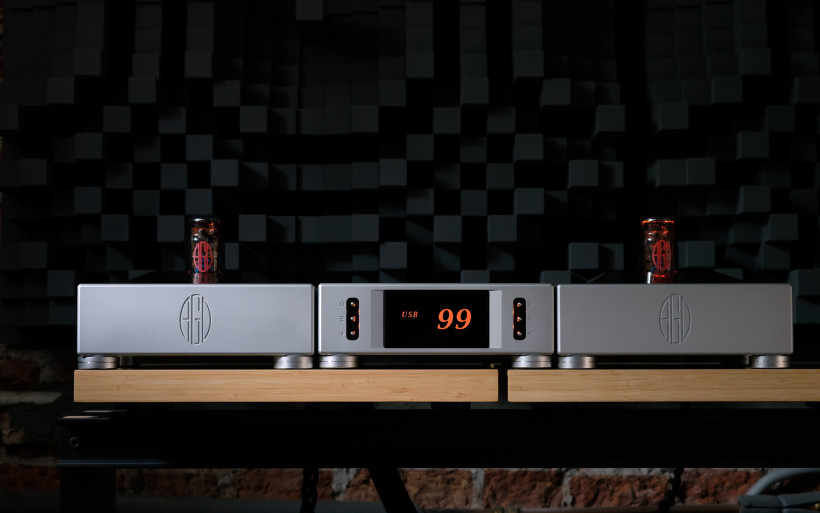 The Andante features a preamplifier, DAC, phono stage, network input, and a Bluetooth receiver. That’s a lot of jobs packed into one compact frame. Alberto clearly designed this multitasker like so to render audio boxes any other than amps as unnecessary. Given that he already has those and they’re dressed as sharply as his Andante, such set plus two speakers and some cables forms the complete package. When it comes to sound quality however, AGD’s lot goes far beyond what its innocent compact look might imply, but we’ll get down to that in a bit. Alberto’s equal seriousness of sonics and domestication is obvious, and his Andante represents what the 21st century high performance audio is all about.
The Andante features a preamplifier, DAC, phono stage, network input, and a Bluetooth receiver. That’s a lot of jobs packed into one compact frame. Alberto clearly designed this multitasker like so to render audio boxes any other than amps as unnecessary. Given that he already has those and they’re dressed as sharply as his Andante, such set plus two speakers and some cables forms the complete package. When it comes to sound quality however, AGD’s lot goes far beyond what its innocent compact look might imply, but we’ll get down to that in a bit. Alberto’s equal seriousness of sonics and domestication is obvious, and his Andante represents what the 21st century high performance audio is all about. Today’s forehead features an interesting screen recessed behind a thick acrylic window, which leaves the impression of displayed information as unusually deep. The view’s great and everything is readable from afar. Orange marks on black background go rather well with the product’s sandblasted silver chassis. Two rows of petite stainless-steel heads in their illuminated acrylic compartments, one per side of the screen, are also unique. These are no buttons, but touch sensors based on capacitance coupling. A gentle touch is all it takes to engage a desired function, in most cases confirmed by a pleasant click. Here it needs to be said that the Andante’s interface is lightning fast. Switches from one menu window to another are on purpose slightly delayed and silent, however input selection, mute on/off and volume up/down actions are instant and make the aforementioned clicky sound. In practice they’re as responsive as one’s own fingers are quick with sensors, and the overall control scheme is as non-standard as it’s practical.
Today’s forehead features an interesting screen recessed behind a thick acrylic window, which leaves the impression of displayed information as unusually deep. The view’s great and everything is readable from afar. Orange marks on black background go rather well with the product’s sandblasted silver chassis. Two rows of petite stainless-steel heads in their illuminated acrylic compartments, one per side of the screen, are also unique. These are no buttons, but touch sensors based on capacitance coupling. A gentle touch is all it takes to engage a desired function, in most cases confirmed by a pleasant click. Here it needs to be said that the Andante’s interface is lightning fast. Switches from one menu window to another are on purpose slightly delayed and silent, however input selection, mute on/off and volume up/down actions are instant and make the aforementioned clicky sound. In practice they’re as responsive as one’s own fingers are quick with sensors, and the overall control scheme is as non-standard as it’s practical.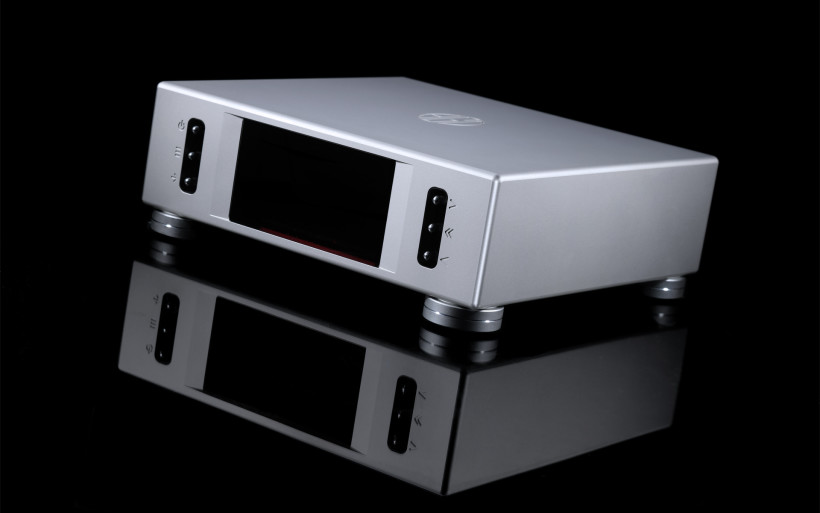 Apple’s handy remote can execute each Andante’s menu function. In there one can change channel balance, invert output phase, reassign RC buttons, adjust display brightness, and set phono input to work with either MM or MC cartridges. The DSP engine features de-emphasis, dithering, and four digital filters (SD sharp/slow, sharp/slow) with the option to bypass them. The product’s top is the extension of the one-piece aluminum enclosure. Its underbelly sports several screws and four aluminium pucks with rubber O-rings, identical as those in Vivace amps. These parts are what keeps the bottom plate in place, which is the only safe way to the Andante’s inside.
Apple’s handy remote can execute each Andante’s menu function. In there one can change channel balance, invert output phase, reassign RC buttons, adjust display brightness, and set phono input to work with either MM or MC cartridges. The DSP engine features de-emphasis, dithering, and four digital filters (SD sharp/slow, sharp/slow) with the option to bypass them. The product’s top is the extension of the one-piece aluminum enclosure. Its underbelly sports several screws and four aluminium pucks with rubber O-rings, identical as those in Vivace amps. These parts are what keeps the bottom plate in place, which is the only safe way to the Andante’s inside.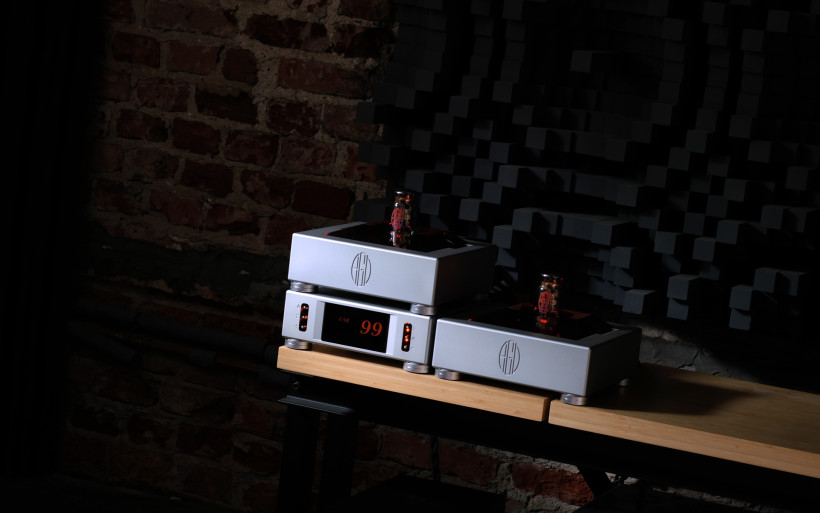 The Andante’s business end is very crowded. Six digital inputs (1 x LAN, 1 x coax S/PDIF, 1 x Toslink S/PDIF, 1 x USB, 1 x AES/EBU, 1 x Bluetooth) sit in the top left corner, whereas all analog inputs (3 x RCA, 1 x XLR) are down below. The first RCA is a phono in, which a ground post just a hair to the left additionally hints. The 12V (0.1A DC) trigger out right behind the detachable BT antenna neighbours with three analog outputs; 1 x XLR and 2 x RCA. The IEC (with easily accessible voltage fuse compartment) on the far-right end closes the list. The Andante’s network component turns it into a Roon endpoint, provides AirPlay plus UPnP/DLNA rendering, and allows for streams up to 24-bit/192kHz. Today’s USB input based on XU208 XMOS chip (and Thesycon’s driver) handles PCM/DSD data up to 32-bit/768kHz/DSD512.
The Andante’s business end is very crowded. Six digital inputs (1 x LAN, 1 x coax S/PDIF, 1 x Toslink S/PDIF, 1 x USB, 1 x AES/EBU, 1 x Bluetooth) sit in the top left corner, whereas all analog inputs (3 x RCA, 1 x XLR) are down below. The first RCA is a phono in, which a ground post just a hair to the left additionally hints. The 12V (0.1A DC) trigger out right behind the detachable BT antenna neighbours with three analog outputs; 1 x XLR and 2 x RCA. The IEC (with easily accessible voltage fuse compartment) on the far-right end closes the list. The Andante’s network component turns it into a Roon endpoint, provides AirPlay plus UPnP/DLNA rendering, and allows for streams up to 24-bit/192kHz. Today’s USB input based on XU208 XMOS chip (and Thesycon’s driver) handles PCM/DSD data up to 32-bit/768kHz/DSD512. Upon powering it on, the Andante greets us with the intro screen for several seconds, to then engage the main menu where currently selected digital input, file type, and the large volume number (0-99) are displayed. Interestingly, my speakers gave the first sign of life no sooner than at about half of the available range. Alberto explained that this is by design due to low gain (6dB) of the circuit, and to have the Andante’s outputs in perfect sync with his amps. The higher the gain factor is, the more noise gets amplified along with volume increase. In practice, numbers as high as 85 on today’s screen are normal at regular listening levels, however it gets plenty loud just five clicks up. If remaining in the upper part of available range is what it takes this time around, given the team Andante/Vivace’s performance that’s fine with me. Besides, not even once I’d encountered a situation where my ideal SPL setting wasn’t there.
Upon powering it on, the Andante greets us with the intro screen for several seconds, to then engage the main menu where currently selected digital input, file type, and the large volume number (0-99) are displayed. Interestingly, my speakers gave the first sign of life no sooner than at about half of the available range. Alberto explained that this is by design due to low gain (6dB) of the circuit, and to have the Andante’s outputs in perfect sync with his amps. The higher the gain factor is, the more noise gets amplified along with volume increase. In practice, numbers as high as 85 on today’s screen are normal at regular listening levels, however it gets plenty loud just five clicks up. If remaining in the upper part of available range is what it takes this time around, given the team Andante/Vivace’s performance that’s fine with me. Besides, not even once I’d encountered a situation where my ideal SPL setting wasn’t there.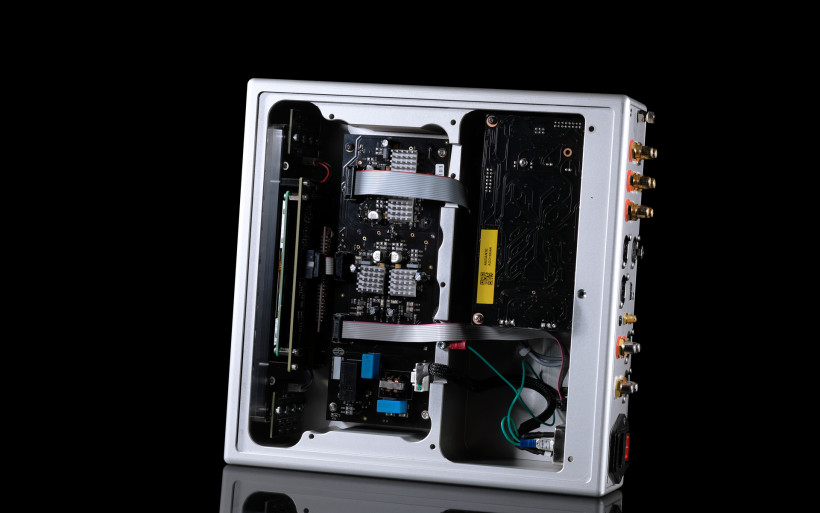 The Andante is made exceptionally well, stable as a rock and a joy to use overall. Although it was on USB duty with my fidata transport for the most part, I’d enjoyed casual YouTube streams via Bluetooth, and AirPlay worked as intended as well. I didn’t get my hands on Tidal, Quobuz and in-built phono stage, as neither vinyl nor streaming from a cloud are a part of my music diet. As far as today’s functionality, visual and operation go, it’s a fully grown and well-executed product. Personally, I didn’t miss anything.
The Andante is made exceptionally well, stable as a rock and a joy to use overall. Although it was on USB duty with my fidata transport for the most part, I’d enjoyed casual YouTube streams via Bluetooth, and AirPlay worked as intended as well. I didn’t get my hands on Tidal, Quobuz and in-built phono stage, as neither vinyl nor streaming from a cloud are a part of my music diet. As far as today’s functionality, visual and operation go, it’s a fully grown and well-executed product. Personally, I didn’t miss anything.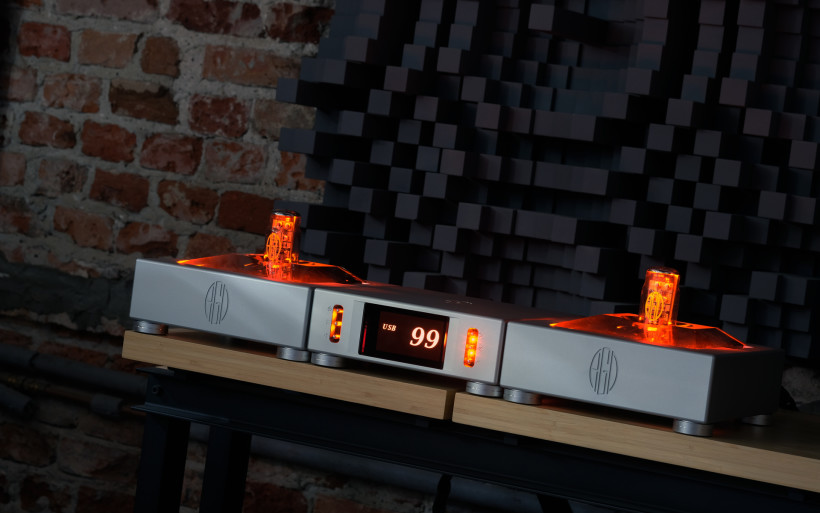 The Andante’s inside features two large chambers. The one near the front stores a display, interface board with a microcontroller, and a switching PSU underneath. Four fully shielded and encapsulated medical grade modules provide voltage step-down from the mains to DC bus, which feeds remaining modules and is subject to linear ultra-low noise regulators (LT3081 and Ti TPS7A4901D), cooled by several small heatsinks. A thick aluminum wall limits interference and noise between components, and sports several narrow gaps for connective wiring.
The Andante’s inside features two large chambers. The one near the front stores a display, interface board with a microcontroller, and a switching PSU underneath. Four fully shielded and encapsulated medical grade modules provide voltage step-down from the mains to DC bus, which feeds remaining modules and is subject to linear ultra-low noise regulators (LT3081 and Ti TPS7A4901D), cooled by several small heatsinks. A thick aluminum wall limits interference and noise between components, and sports several narrow gaps for connective wiring.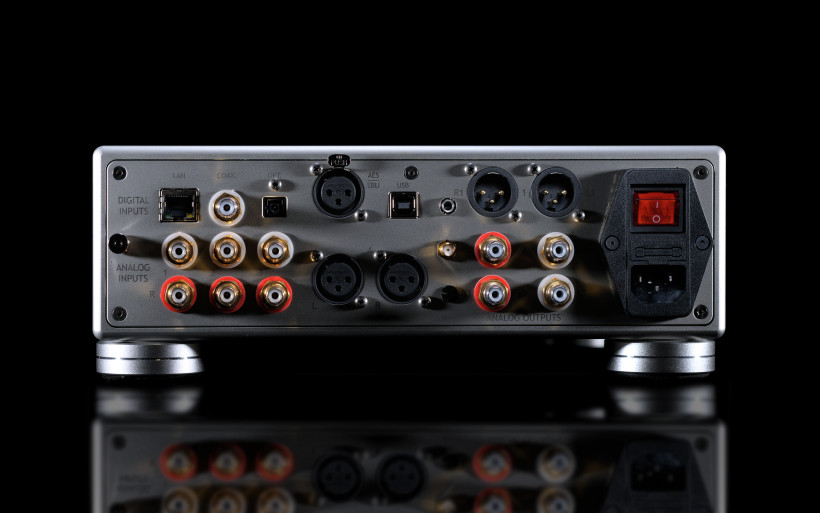 The rear chamber houses two main PCBs. The one with analog I/O and the ladder attenuator connects to a small phono stage daughter board, whereas the other comprises of digital I/O plus USB receiver, and has a smaller DAC module attached to it. All incoming digital data is re-clocked. The Andante’s 8-bit attenuation ladder includes 16 industry grade relays in total. Each put inside of its own petite housing is resilient to all external factors and should outlast any regular counterpart. Four D/A chips used in today’s are R2R types designed for jobs in the industrial sector. The buffer board is mounted directly on the output block and based on THAT company’s pro audio chipset, developed to record analog sources.
The rear chamber houses two main PCBs. The one with analog I/O and the ladder attenuator connects to a small phono stage daughter board, whereas the other comprises of digital I/O plus USB receiver, and has a smaller DAC module attached to it. All incoming digital data is re-clocked. The Andante’s 8-bit attenuation ladder includes 16 industry grade relays in total. Each put inside of its own petite housing is resilient to all external factors and should outlast any regular counterpart. Four D/A chips used in today’s are R2R types designed for jobs in the industrial sector. The buffer board is mounted directly on the output block and based on THAT company’s pro audio chipset, developed to record analog sources.
Sound
My fidata HFAS1-S10U handled storage and transport, then either the Andante or LampizatOr Pacific DAC (KR Audio T-100/Living Voice 300B + KR Audio 5U4G Ltd. Ed.) took over to pass the signal to Vivace mono amps, with and without Thöress DFP line stage in-between. From there a Boenicke Audio S3 speaker cable stepped in to connect to Boenicke Audio W11SE+ floorstanders, or Spendor Classic 1/2. All amps were powered by LessLoss C-MARCs from a GigaWatt PC-3 SE EVO+ power conditioner, fronted by the same manufacturer’s LC-3 EVO cable. Interconnects used were Boenicke Audio IC3 CG and Audiomica Laboratory Erys Excellence if needed. The USB chain included the full iFi audio stack; a micro iUSB3.0, nano iGalvanic3.0, three Mercury USB cables in-between plus one 9V iPower. At some point today’s also fronted Kinki Studio’s EX-M1 integrated amp. AMR DP-777SE and iFi audio Pro iDSD were used solely as supportive D/A converters as well.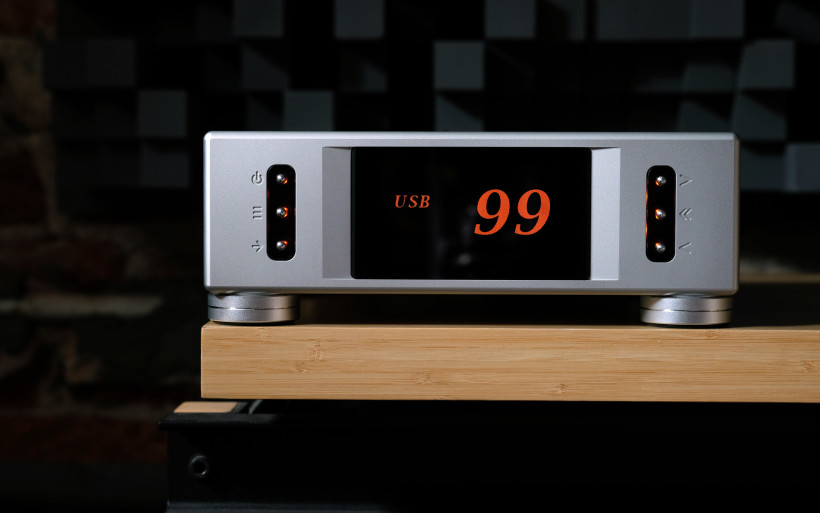 It’s fair to point out again that the Andante was designed for individuals into reduction of their audio hardware and not the other way around, which is why to review it as a standalone all-in-one box seemed the way to go. However, its complexity plus a series of “what if?” questions of my own, in effect led to several highly unrealistic usage scenarios and the usual routine accordingly expanded. Even though most people wouldn’t go this route, my plan involved each Andante’s key function tested separately, just so I could thoroughly investigate Alberto’s work outside of the amplification turf. Let’s thus blame my own curiosity here.
It’s fair to point out again that the Andante was designed for individuals into reduction of their audio hardware and not the other way around, which is why to review it as a standalone all-in-one box seemed the way to go. However, its complexity plus a series of “what if?” questions of my own, in effect led to several highly unrealistic usage scenarios and the usual routine accordingly expanded. Even though most people wouldn’t go this route, my plan involved each Andante’s key function tested separately, just so I could thoroughly investigate Alberto’s work outside of the amplification turf. Let’s thus blame my own curiosity here.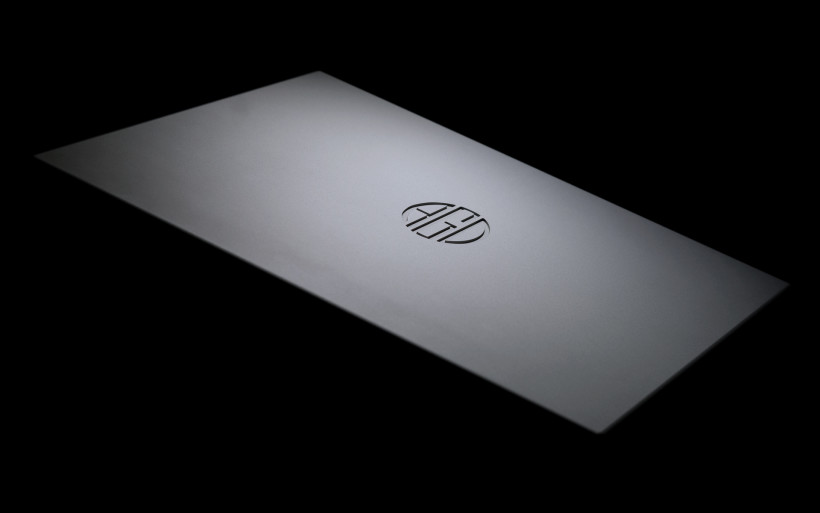 The Andante’s in-built DAC module was the first subject tackled. In order to bypass this circuit, my LampizatOr connected to today’s RCA inputs, and then one of these received data from the fidata via USB. A single cable swap was all there was to it on the hardware front, whereas Apple’s RC handled desired input change plus volume adjustment to match levels. The procedure was as fast as it was convenient. But most importantly, it was fair to assume that a $30’000 standalone D/A converter with top shelf glass on board should improve a thing or two. Not today.
The Andante’s in-built DAC module was the first subject tackled. In order to bypass this circuit, my LampizatOr connected to today’s RCA inputs, and then one of these received data from the fidata via USB. A single cable swap was all there was to it on the hardware front, whereas Apple’s RC handled desired input change plus volume adjustment to match levels. The procedure was as fast as it was convenient. But most importantly, it was fair to assume that a $30’000 standalone D/A converter with top shelf glass on board should improve a thing or two. Not today.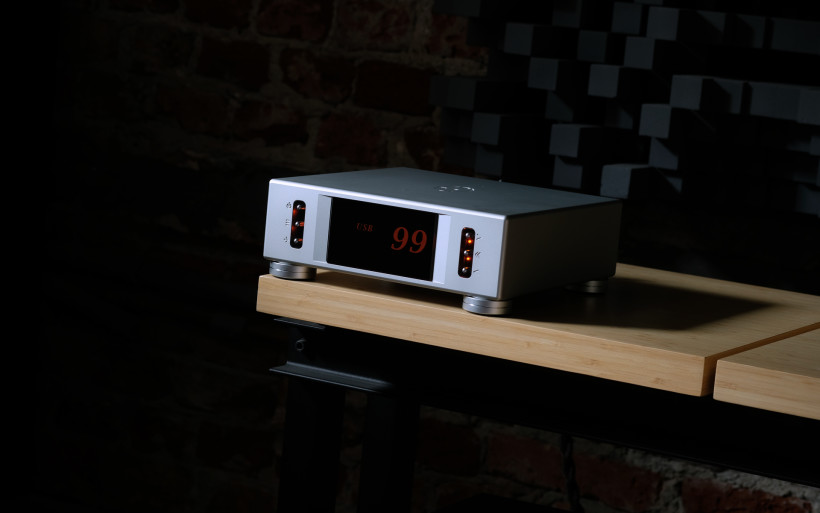 When my Pacific DAC was connected for the first time, the effect was as open, spatially expansive, and expressive in the midrange (due to quality 300B/5U4G specimens by KR Audio) as per usual. However, brittleness, hollowness, low torque and on-stage dilution indicated that something clearly wasn’t right. The more shifts I had under my belt, the more and more obvious it became that Andante’s in-built digital circuit was the supreme leader. The gap that formed was substantial enough that no cables or tweaks could make it any smaller. Alberto’s machine exploited as a DAC not only wasn’t hollow or shouty, but it also sounded gutsier, fuller, speedier, and was seasoned noticeably better on top of that. Each time I returned to my daily driver, everything collapsed. With Alberto’s device music blossomed again. The key difference was in how it created space in front of me, how visually attractive all virtual sound sources it had, and how pleasantly resonantly it sounded. Along with Vivace monos, the Andante had both bite and saturation in check, and sounded very much complete.
When my Pacific DAC was connected for the first time, the effect was as open, spatially expansive, and expressive in the midrange (due to quality 300B/5U4G specimens by KR Audio) as per usual. However, brittleness, hollowness, low torque and on-stage dilution indicated that something clearly wasn’t right. The more shifts I had under my belt, the more and more obvious it became that Andante’s in-built digital circuit was the supreme leader. The gap that formed was substantial enough that no cables or tweaks could make it any smaller. Alberto’s machine exploited as a DAC not only wasn’t hollow or shouty, but it also sounded gutsier, fuller, speedier, and was seasoned noticeably better on top of that. Each time I returned to my daily driver, everything collapsed. With Alberto’s device music blossomed again. The key difference was in how it created space in front of me, how visually attractive all virtual sound sources it had, and how pleasantly resonantly it sounded. Along with Vivace monos, the Andante had both bite and saturation in check, and sounded very much complete.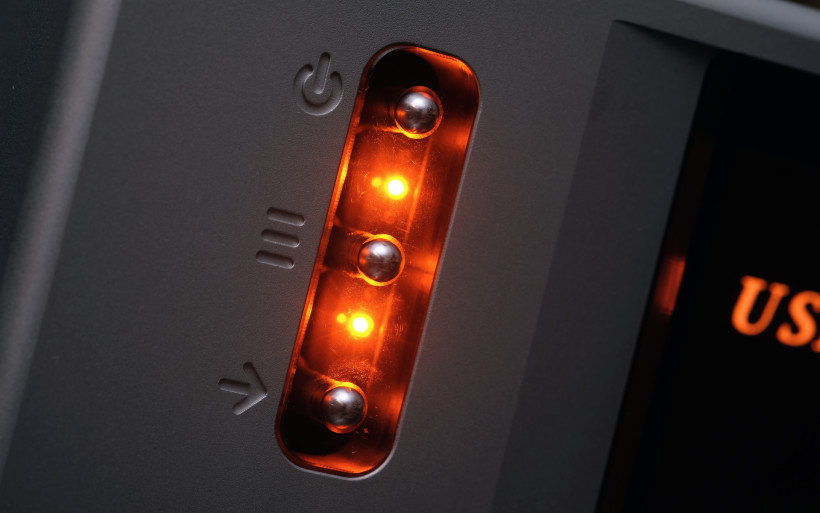 There’s no exaggeration in labeling the two listed D/A circuits’ clash as a bloodbath. The disparity was simply too severe to lessen it in any way. I knew well that this was but a mere shadow of the Pacific DAC I purchased many months ago. The last and only time I’d heard it so underwhelmed was during the Dutch&Dutch 8C assignment. Heck, even all symptoms back then and now were quite similar if not the same. That’s why I entertained the thought that perhaps Alberto’s DAC in his Andante was quite unmatched for the same reason. Perhaps this was one of those rare cases capable of working at their best only if used alone. If so, this would then scream major savings and today’s tremendous advantage. After all, why spending hefty coin on a standalone DAC if it’s most likely a severe downgrade? At this point this was only my theory, but it so happened that I had just the tools to investigate further and possibly find any proof.
There’s no exaggeration in labeling the two listed D/A circuits’ clash as a bloodbath. The disparity was simply too severe to lessen it in any way. I knew well that this was but a mere shadow of the Pacific DAC I purchased many months ago. The last and only time I’d heard it so underwhelmed was during the Dutch&Dutch 8C assignment. Heck, even all symptoms back then and now were quite similar if not the same. That’s why I entertained the thought that perhaps Alberto’s DAC in his Andante was quite unmatched for the same reason. Perhaps this was one of those rare cases capable of working at their best only if used alone. If so, this would then scream major savings and today’s tremendous advantage. After all, why spending hefty coin on a standalone DAC if it’s most likely a severe downgrade? At this point this was only my theory, but it so happened that I had just the tools to investigate further and possibly find any proof.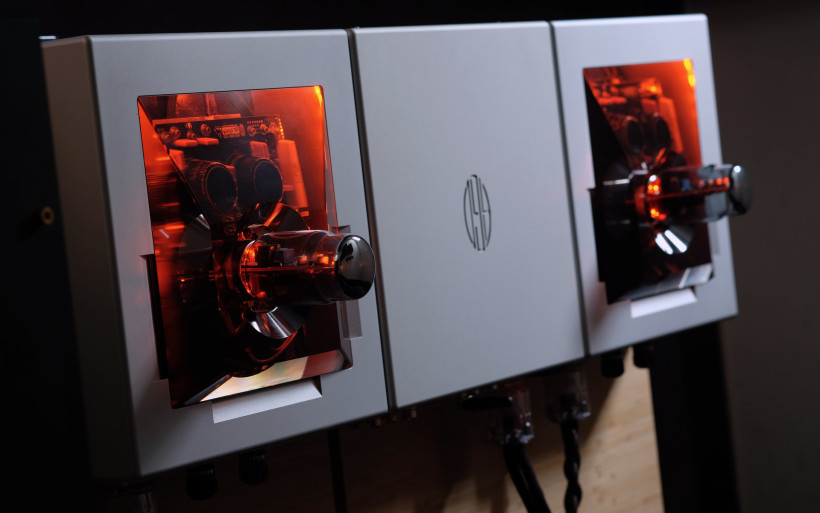 At first, I thought that perhaps for some reason the Andante simply favoured XLR connections, which my main DAC didn’t provide. That’s why two other fully balanced devices – Pro iDSD and AMR DP-777SE – had to step in, used exactly like the Pacific. Although results were somewhat different, I’ll spare you details. Suffice to say, two extra corpses were carried out of my place in two separate body bags. If connected to the Andante, neither standalone DAC I had nearby performed like it used to, and that’s the key thing to take note of. Their similar handicap formed a firm pattern I could hold on to, but there was one extra task I could do to fully know what today’s D/A module was truly capable of.
At first, I thought that perhaps for some reason the Andante simply favoured XLR connections, which my main DAC didn’t provide. That’s why two other fully balanced devices – Pro iDSD and AMR DP-777SE – had to step in, used exactly like the Pacific. Although results were somewhat different, I’ll spare you details. Suffice to say, two extra corpses were carried out of my place in two separate body bags. If connected to the Andante, neither standalone DAC I had nearby performed like it used to, and that’s the key thing to take note of. Their similar handicap formed a firm pattern I could hold on to, but there was one extra task I could do to fully know what today’s D/A module was truly capable of.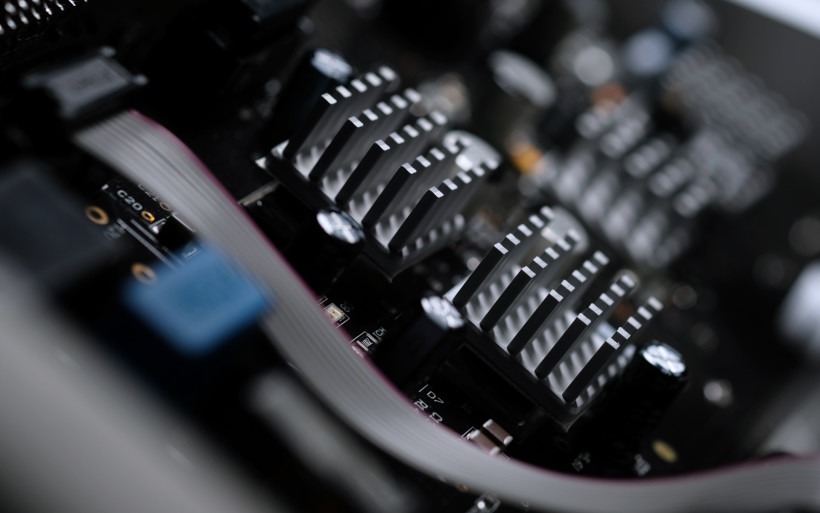 Up to this point all auditions included Alberto’s Vivace monos as the natural choice, but it was time to replace these with Kinki Studio’s EX-M1 integrated amp. With its own attenuation bypassed and internal D/A circuit nicely isolated, the Andante connected to the Chinese deck and so did the Pacific. As previously, I had to swap one USB cable and switch inputs this time on the Kinki’s RC. Long story’s short, I got my costly LampizatOr back, now it finally sounded just the way it should. Against the AGD my daily tool’s attitude was snappier, leaner, more articulate and chiseled. The Pacific more keenly granted me insight into events in front, had key virtual sound sources isolated better, painted more explicitly and moved a bit forward versus today’s. The local DAC also had a slight upper hand on spatial sizing and slamming might at the very bottom. It was spicier, sunnier and more expressive with voices and natural instruments.
Up to this point all auditions included Alberto’s Vivace monos as the natural choice, but it was time to replace these with Kinki Studio’s EX-M1 integrated amp. With its own attenuation bypassed and internal D/A circuit nicely isolated, the Andante connected to the Chinese deck and so did the Pacific. As previously, I had to swap one USB cable and switch inputs this time on the Kinki’s RC. Long story’s short, I got my costly LampizatOr back, now it finally sounded just the way it should. Against the AGD my daily tool’s attitude was snappier, leaner, more articulate and chiseled. The Pacific more keenly granted me insight into events in front, had key virtual sound sources isolated better, painted more explicitly and moved a bit forward versus today’s. The local DAC also had a slight upper hand on spatial sizing and slamming might at the very bottom. It was spicier, sunnier and more expressive with voices and natural instruments.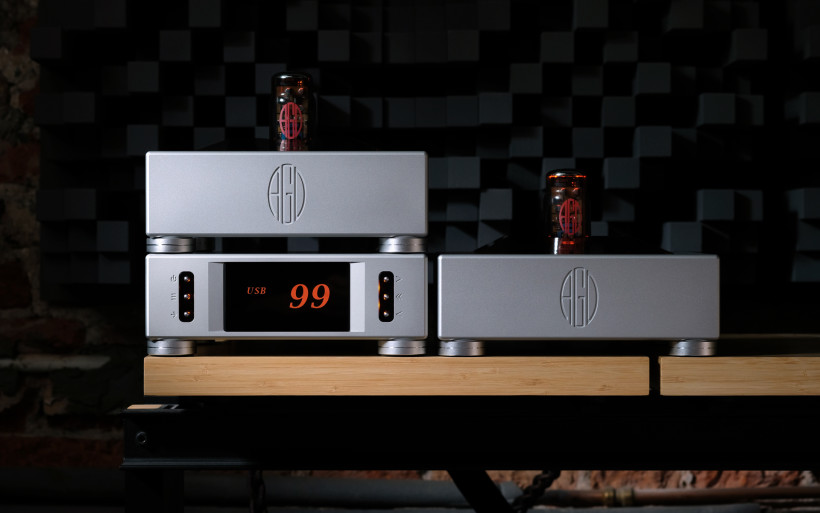 In spite of the Pacific now locked into the highest gear, the Andante didn’t leave my place stiff in yet another body bag, not at all. Although I could tell that my own DAC was the upper echelon specimen of the two, Alberto’s D/A circuit did a number of quite remarkable and clever things on its own. Its heftier and earthlier disposition changed a lot all by itself, but the overall sonic profile of this device brimmed with a very particular textural filler, as inherently organic as it was pleasantly familiar. The LessLoss Echo’s End reviewed a while ago followed the alike path, but went several extra miles further in this direction. In this context I’d thus position the Andante’s voicing somewhere in-between the Lithuanian DAC and my happily hi-rez Pacific machine, albeit a fair bit closer to the former. But most importantly, Alberto’s circuit sounded very mature, dare I say suspiciously good considering it being a part of an integrated product. In most cases D/A boards are just functionality extenders not capable of going toe to toe with quality standalone decks, but AGD’s circuit clearly could.
In spite of the Pacific now locked into the highest gear, the Andante didn’t leave my place stiff in yet another body bag, not at all. Although I could tell that my own DAC was the upper echelon specimen of the two, Alberto’s D/A circuit did a number of quite remarkable and clever things on its own. Its heftier and earthlier disposition changed a lot all by itself, but the overall sonic profile of this device brimmed with a very particular textural filler, as inherently organic as it was pleasantly familiar. The LessLoss Echo’s End reviewed a while ago followed the alike path, but went several extra miles further in this direction. In this context I’d thus position the Andante’s voicing somewhere in-between the Lithuanian DAC and my happily hi-rez Pacific machine, albeit a fair bit closer to the former. But most importantly, Alberto’s circuit sounded very mature, dare I say suspiciously good considering it being a part of an integrated product. In most cases D/A boards are just functionality extenders not capable of going toe to toe with quality standalone decks, but AGD’s circuit clearly could.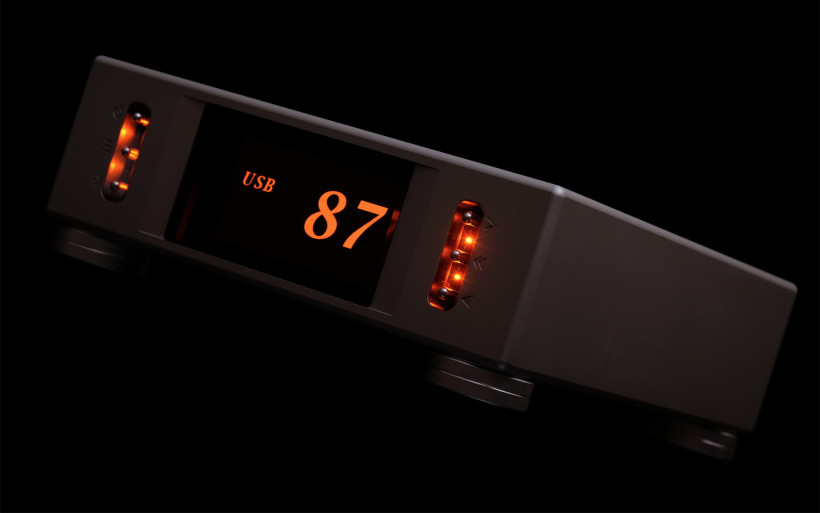 My Pacific magnifies recording quality very well, to a point where I must cherry-pick music to actually enjoy it. The Andante’s DAC on this specific count not only was more forgiving, but it also finely amplified guttural qualities in each track to effectively sound more gravitational and likable in many cases. Although it staged a bit smaller than the LampizatOr, grand and substantial aural landscapes it provided upon demand very effortlessly, but what impressed me the most was found elsewhere. The Andante behaved meticulously, calmly and in delightfully composed fashion regardless of music type. In spite of being positioned below my daily DAC on that final bit of expression, articulation and refinement, today’s gutsier and softer disposition oftentimes provided more joy. I think that many individuals would most likely agree that, with the EX-M1 on duty, two noticeably different voicings clashed. What’s inside the Andante is in reality a full-fledged killer DAC, and I wouldn’t be surprised to see it as a standalone product under the AGD Productions banner somewhere in the future.
My Pacific magnifies recording quality very well, to a point where I must cherry-pick music to actually enjoy it. The Andante’s DAC on this specific count not only was more forgiving, but it also finely amplified guttural qualities in each track to effectively sound more gravitational and likable in many cases. Although it staged a bit smaller than the LampizatOr, grand and substantial aural landscapes it provided upon demand very effortlessly, but what impressed me the most was found elsewhere. The Andante behaved meticulously, calmly and in delightfully composed fashion regardless of music type. In spite of being positioned below my daily DAC on that final bit of expression, articulation and refinement, today’s gutsier and softer disposition oftentimes provided more joy. I think that many individuals would most likely agree that, with the EX-M1 on duty, two noticeably different voicings clashed. What’s inside the Andante is in reality a full-fledged killer DAC, and I wouldn’t be surprised to see it as a standalone product under the AGD Productions banner somewhere in the future. Once I knew how the Andante behaved as a digital end, it was time to see how its volume control fared against a standalone preamplifier. Vivace monos went into play once more. The goal was to either drive them directly from Alberto’s integrated via XLRs, or use it only as a DAC on duty with Thöress DFP line stage. The former scenario meant RCAs and the Andante’s volume bypassed. Having the D/A shootout in mind, one extra spot at the ossuary was booked, however this time around it wasn’t needed. The DFP did far better than my Pacific, and the fight was quite even-handed. Today’s volume versus the DFP was a bit thicker and the whole setup sported that meticulous meaty attitude I already mapped. The standalone preamplifier in-between increased euphony, boosted vocal and instrumental sizing, brought the first row a bit closer, and packed even more punch at the bottom. There were no bad choices here, and both were as different as they were interesting and entertaining.
Once I knew how the Andante behaved as a digital end, it was time to see how its volume control fared against a standalone preamplifier. Vivace monos went into play once more. The goal was to either drive them directly from Alberto’s integrated via XLRs, or use it only as a DAC on duty with Thöress DFP line stage. The former scenario meant RCAs and the Andante’s volume bypassed. Having the D/A shootout in mind, one extra spot at the ossuary was booked, however this time around it wasn’t needed. The DFP did far better than my Pacific, and the fight was quite even-handed. Today’s volume versus the DFP was a bit thicker and the whole setup sported that meticulous meaty attitude I already mapped. The standalone preamplifier in-between increased euphony, boosted vocal and instrumental sizing, brought the first row a bit closer, and packed even more punch at the bottom. There were no bad choices here, and both were as different as they were interesting and entertaining.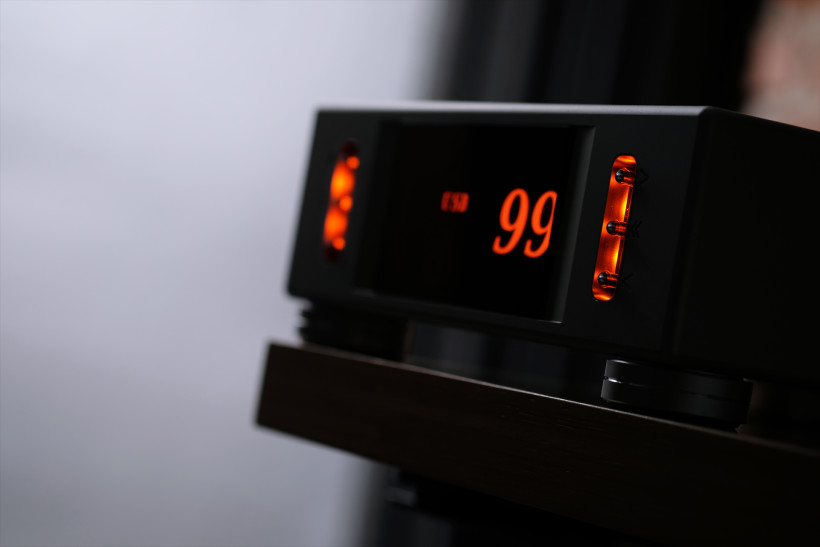 I’d enjoyed the Andante directly connected to Vivace monos more. This simple three-piece set struck the perfect balance on propulsion, textural filler, openness, moisture and spatial sizing, but this was of minor importance in the context of several very interesting discoveries. The Andante clearly didn’t enjoy being fronted by a standalone DAC, but I look forward to Srajan’s own input on the subject. It also goes without saying that today’s volume control module worked very well with Vivace monos, however it’s good to know that this specific juncture provides room for potential flavoring shifts. I haven’t got the faintest what would it take to best AGD’s internal volume circuit. The DFP I had at my disposal led to a significant move sideways but not up.
I’d enjoyed the Andante directly connected to Vivace monos more. This simple three-piece set struck the perfect balance on propulsion, textural filler, openness, moisture and spatial sizing, but this was of minor importance in the context of several very interesting discoveries. The Andante clearly didn’t enjoy being fronted by a standalone DAC, but I look forward to Srajan’s own input on the subject. It also goes without saying that today’s volume control module worked very well with Vivace monos, however it’s good to know that this specific juncture provides room for potential flavoring shifts. I haven’t got the faintest what would it take to best AGD’s internal volume circuit. The DFP I had at my disposal led to a significant move sideways but not up.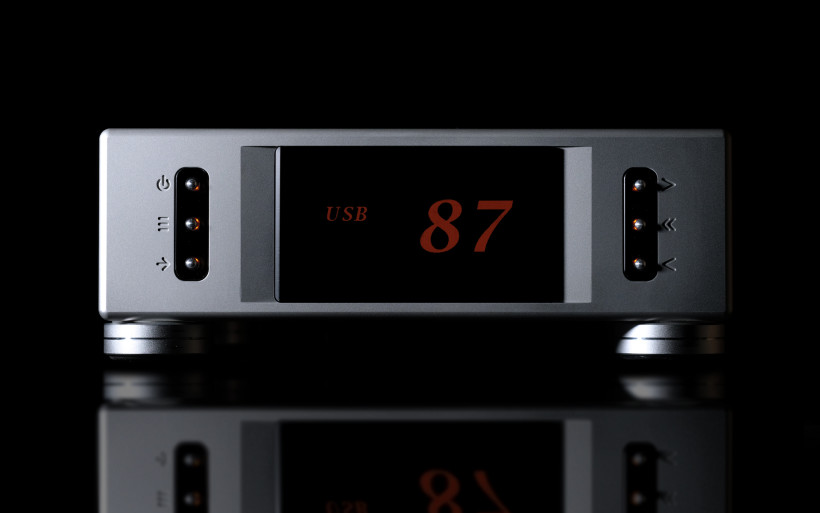 There’s one major sonic reason why the Andante worked truly well with its kin. Carefully applied density and organic tissue are the very core of its already well-seasoned voicing, and Alberto’s speedy insightful monos were exceptionally fond of these particular qualities. His products’ conjoined effort resulted in aural synergy grand enough to surpass pretty much any other setup combination I could come up with. The only hardware combo capable of throwing punches against the simple Andante/Vivace set (with Boenicke W11 SE+ speakers) included my Pacific, the DFP line stage and… Vivace amps. You do the math. The key evaluation phase of Alberto’s three-piece system was a case closed in mere two days or so, even though this lot guested for three weeks more. During that time all remaining hardware except fidata gathered dust. I simply had no incentive to get back to it, and I think that this speaks for itself.
There’s one major sonic reason why the Andante worked truly well with its kin. Carefully applied density and organic tissue are the very core of its already well-seasoned voicing, and Alberto’s speedy insightful monos were exceptionally fond of these particular qualities. His products’ conjoined effort resulted in aural synergy grand enough to surpass pretty much any other setup combination I could come up with. The only hardware combo capable of throwing punches against the simple Andante/Vivace set (with Boenicke W11 SE+ speakers) included my Pacific, the DFP line stage and… Vivace amps. You do the math. The key evaluation phase of Alberto’s three-piece system was a case closed in mere two days or so, even though this lot guested for three weeks more. During that time all remaining hardware except fidata gathered dust. I simply had no incentive to get back to it, and I think that this speaks for itself.
Summary
After the impression left by fantastic Vivace mono amps, their maker significantly raised the bar for any such upcoming hardware and also his own designs. Although AGD Productions Andante at first struck me mainly as the next step to logically complete the roster and unlock the sleek three-piece route, it also emerged as very serious on sound performance, and as far away from being just a portfolio extender as it gets.
The Andante scores very high on put-togetherness, petite footprint, responsiveness, rapid readiness, stability, freedom from hiccups, and connectivity. Alberto Guerra didn’t cut any corners and thought about literally everything. Even on packaging he went the extra mile to effectively push beyond today’s price point. The Andante was nothing short but joy to use. Perhaps in the long run something to fix or rework would eventually emerge, but during its extensive duty at my place nothing did. Simply put, it’s a fully mature well-engineered product.
To say that AGD Productions Andante introduced itself as full of sonic surprises, is to put it mildly. Let me stress again that it rendered all my standalone DACs as useless, and I’m not aware of any other functionally similar device capable of pulling this off. Its clever voicing matched Vivace mono amps spectacularly enough for me to forget about my main rig for nearly a month, which is why I’d take this compact set into serious consideration if I were into shrinking my audio game. It sounded this good and its components were clearly made for each other, however AGD Productions Andante is the one that made it all click. Considering how much hardware this luxo full-care package replaced, how it went about it and how future-proof it turned out to be against the upgrade bug, its asking price I see as highly realistic. My tip of the hat to today’s talented maker and ‘til next time!
Associated Equipment:
- Amplifier: AGD Productions Vivace, Kinki Studio EX-M1
- DAC: LampizatOr Pacific (KR Audio T-100 / Living Voice 300B + KR Audio 5U4G Ltd. Ed.), ifi audio Pro iDSD, AMR DP-777SE
- Speakers: Boenicke Audio W11 SE+, Spendor Classic 1/2
- Transport: fidata HFAS1-S10U
- Line stage: Thöress DFP
- Speaker cables: Boenicke Audio S3, LessLoss C-MARC
- Interconnects: Boenicke Audio IC3 CG, Audiomica Laboratory Erys Excellence
- Power components: Gigawatt PC-3 SE EVO+, Gigawatt PF-2 + Gigawatt LC-2 MK2 + Audiomica Laboratory Ness Excellence/LessLoss C-MARC
- Rack: Franc Audio Accesories Wood Block Rack
- Music: NativeDSD, Roon
Retail prices of reviewed components (excl. tax, sold directly):
- AGD Productions Andante: $12’499
Manufacturer: AGD Productions





























